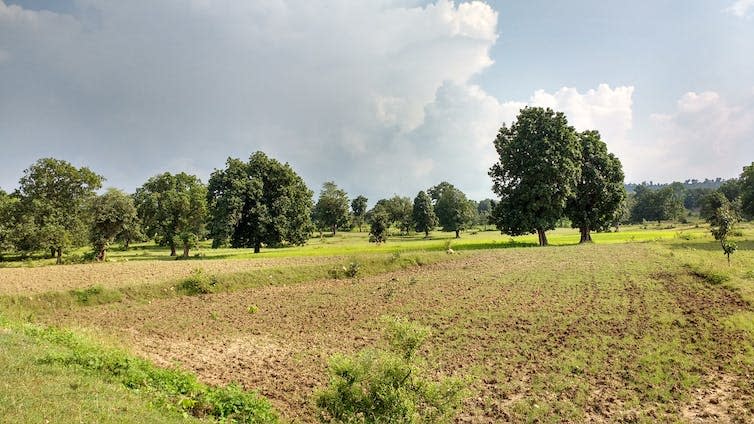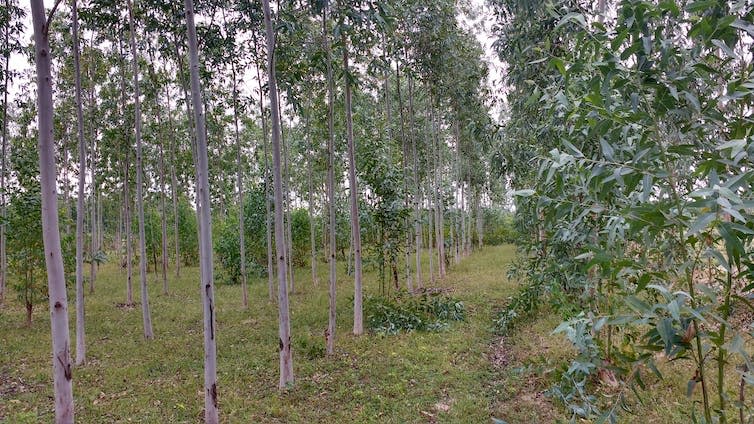Imagine making one change in a farm field that not only produces food, but also generates building materials, fuel and feed. At the same time, this change would promote soil health, regulate the microclimate and support pest control. In fact, it could even produce a completely different crop.
All these things could be possible by simply planting trees among crops – and not just trees, but shrubs, palms and bamboo.
This approach to farming is known as agroforestry and experts believe it could improve the sustainability of agriculture worldwide. On a large scale, it could help mitigate climate change by storing more carbon in land that can still serve other purposes. Countries can even count trees planted on agricultural land towards their reforestation obligations.
There is a lot of room for planting trees on farms in South Asia and sub-Saharan Africa. But many of these plots are small: on average less than 2 hectares (or two football fields). Any use of space must really deserve it.
How do we make trees work for farmers and the planet? India, which has seen phenomenal changes in agroforestry over the past two decades, offers some insight.
India’s agroforestry experiment
India’s first attempt to get more trees on farms began in 1999 with the Lok Vaniki program in Madhya Pradesh, a state in central India. The state government initiated the scheme to help farmers with degraded land secure additional income from timber and provided them with teak saplings.
The plan got off to a rocky start. India’s Supreme Court had banned all logging except those allowed under the forestry plan three years earlier. Before farmers could sell the wood they grew, their request to cut down the tree had to be approved by the government.
Farmers were afraid to plant something they might not get permission to harvest, and teak trees take 20 years to yield wood. A cumbersome process for obtaining permits and high transportation costs for small and marginal farmers disrupted the plan.
The state responded by exempting certain trees from felling regulations. In 2014, India had a national agroforestry policy that offered farmers saplings and simpler procedures for harvesting and transporting trees. Yet tree cover on farms did not shrink. According to a study I contributed to, there has been a serious decline in the number of trees on farms in India over the past decade.
The decline was pronounced among mature trees. Once upon a time, these gnarled veterans had shaded open wells on farms and kept water from evaporating in the sun’s glare. Now deeper wells could be dug, making such trees redundant.
The expansion of mechanized agriculture placed a premium on treeless fields where tractors and farm vehicles could easily maneuver. Attacks by fungal parasites claimed other trees.
Some farmers were unsentimental. In interviews, many said they saw little benefit from trees, which could prevent sunlight from reaching crops. But the demise of native farm trees like neem, mahua and jamun, once prized for their medicinal oils and nutritious fruits, threatened rural diets, especially in the poorest regions.

Trees on farms, not tree nurseries
As the number of agricultural lands across India dwindled, block plantations expanded. These are essentially farms where only trees grow.
These plantations consist largely of exotic and fast-growing trees such as eucalyptus, poplar and casuarina, all of which are exempt from felling regulations. Tempted by the prospect of generating carbon credits on the international carbon market, and by demand for pulpwood for papermaking, farmers with some of the smallest plots in India sought to shift their crops to block plantations.
When the price of carbon credits fell following the collapse of the UN Clean Development Mechanism in 2012, these small farmers had little to offer. A survey later confirmed that many would have been better off if they had kept their land for agriculture.


Although there is an increasing demand for pulpwood and timber in India, this is likely to favor farmers who can plant in large areas, cover harvesting and transport costs and wait for returns from the plantations – a situation that small and marginal farmers cannot afford.
These exotic plantations are not a boon for the environment either. For example, eucalyptus uses a lot of water and soil nutrients, making the land less fertile for future cultivation. The leaves and flowers are less useful to birds than many native trees.
There is a global rush to plant more trees on farms without thinking about what farmers will do with the tree in twenty years, or how it might disrupt crop production. This problem is not unique to India and has been noted elsewhere, including in Kenya.
Trees should still be encouraged on farms; preferably native trees that are beneficial for local diets and medicines. So far, however, the trend in India and elsewhere has been towards block plantations of exotic trees – a phenomenon driven largely by the allure of carbon credits.
The focus should be on supporting small and marginal farmers in growing indigenous trees sustainably. Scattered trees of many species on small farms have greater benefits for farmers and the environment than single-species plantations.
However, in order to achieve this, there must be a way to finance this process. If carbon credit mechanisms can recognize this model of agroforestry and help smallholder farmers add trees to their croplands, it would be a major shift in the right direction.


Don’t have time to read as much about climate change as you’d like?
Instead, get a weekly digest in your inbox. Every Wednesday, The Conversation’s environmental editor writes Imagine, a short email that delves a little deeper into just one climate issue. Join over 30,000 readers who have subscribed so far.
This article is republished from The Conversation under a Creative Commons license. Read the original article.


Dhanapal Govindarajulu does not work for, consult with, own shares in, or receive funding from any company or organization that would benefit from this article, and has disclosed no relevant affiliations beyond their academic appointment.